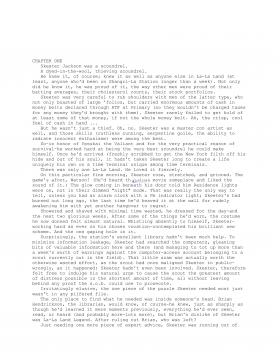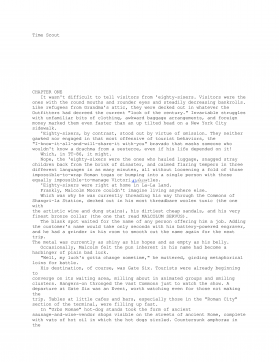
landing had been required for the distant controllers to find and match the slightly different frequencies
now needed to operate it. The eyes, which had seen so clearly hi empty space, had to adjust so that the
different index of refraction between the diamond and the new external medium did not blur their pictures
hopelessly. This did not take too long, as it was automatic, effected by the atmosphere itself as it filtered
through minute pores into the spaces between certain of the lens elements,
Once optically adjusted, the nearly complete darkness meant nothing to those eyes, for the multipliers
behind them made use of every quantum of radiation the diamond could refract. Far away, human eyes
glued themselves to vision screens which carried the relayed images of what the machine saw.
It was a rolling landscape, not too unearthly at first
10 CLOSE TO CRITICAL
glance. There were large hills in the distance, their outlines softened by what might have been forests. The
nearby ground was completely covered with vegetation which looked more or less like grass, though the visible
trail the robot had already left suggested that the stuff was far more brittle. Clumps of taller growths erupted at
irregular intervals, usually on higher ground. Nothing seemed to move, not even the thinnest fronds of the
plants, though an irregular crashing and booming registered almost constantly on the sound pickups built into
the plastic block. Except for the sound it was a still-life landscape, without wind or animal activity.
The machine gazed thoughtfully for many minutes. Probably its distant operators were hoping that life fright-
ened into hiding by its fall might reappear; but if this were the case they were disappointed for the moment.
After a time it crawled back to the remains of its parachute harness and played a set of lights carefully over the
collection of metal girders, cables, and ribbons, examining them all in great detail. Then it moved away again,
this time with a purposeful air.
For the next ten hours it quartered meticulously the general area of the landing, sometimes stopping to play its
light on some object like a plant, sometimes looking around for minutes on end without obvious purpose,
sometimes emitting sounds of varying pitch and loudness. This last always happened when it was in a valley, or
at least not on the very top of a hill; it seemed to be studying echoes for some reason.
Periodically it went back to the abandoned harness and repeated the careful examination, as though it were
expecting something to happen. Naturally, in an environment having a three hundred-seventy-degree
temperature, about eight hundred atmospheres pressure, and a climate consisting of water heavily laced with
oxygen and oxides of sulphur, things started to happen soon enough; and great interest was shown in the
progress of the corrosion
Prologue: Investigation; Annexation 11
as it steadily devoured the metal. Some parts lasted longer than others; no doubt the designers had
included different alloys, perhaps to check this very point. The robot remained in the general area until the
last of the metal had vanished in slime.
At irregular intervals during this time, the surface of the ground shook violently. Sometimes the shaking
was accompanied by the crashes which had first greeted the robot's "ears"; at other times it was relatively
silent. The operators must have been bothered by this at first; then it became evident that all the hills in the
neighborhood were well rounded with no steep cliffs, and that the ground itself was free of both cracks
and loose stones, so there was little reason to worry about the effect of quakes on the fabulously expensive
mechanism.
A far more interesting event was the appearance of animal life. Most of the creatures were small, but were
none the less fascinating for that, if the robot's actions meant anything. It examined everything that
appeared, as closely as it possibly could. Most of the creatures seemed to be scale-armored and eight-
limbed; some appeared to live on the local vegetation, others, on each other.
With the harness finally gone, the attention of the robot's operators was exclusively occupied by the ani-
mals for a long time. The investigation was interrupted a number of times, but this was due to loss of
control rather than distraction. The lack of visible surface features on Tenebra had prevented the men from
getting a very precise measure of its rotation period, and on several occasions the distant ship "set" as far
as the important part of the planet was concerned. Trial and error gradually narrowed down the
uncertainties in the length of Tenebra's day, however, and the interruptions in control finally vanished.
The project of studying a planet three times the diameter of Earth looked rather ridiculous when attempted
12

 2024-12-08 12
2024-12-08 12
 2024-12-08 14
2024-12-08 14
 2024-12-08 10
2024-12-08 10
 2024-12-08 10
2024-12-08 10
 2024-12-08 15
2024-12-08 15
 2024-12-08 18
2024-12-08 18
 2024-12-08 27
2024-12-08 27
 2024-12-08 25
2024-12-08 25
 2024-12-08 16
2024-12-08 16
 2024-12-08 30
2024-12-08 30








 渝公网安备50010702506394
渝公网安备50010702506394
